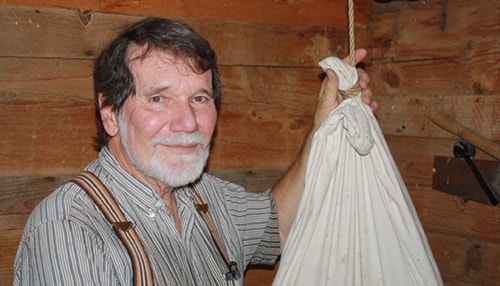Serendipity.
Keremeos Grist Mill curator Cuyler Page believes his career and the development of the historic property are the result of a number of happy coincidences.
He may be right. It’s hard to imagine another individual more suited to the task of restoring the mill - accurately - to its glory days of the 1870s than Page, who has been an integral part of the property’s renaissance since its purchase from private interests by the province in the 1980s.
A product of the East, Page grew up in the university town of Ithaca, New York.
“My parents loved history. It’s been a natural part of my life, visiting historic sites, imagining what the past was like.”
Page eventually went on to higher education in his hometown university - Cornell - studying architecture.
“I apprenticed with a futuristic architect by the name of Paolo Solari,” he explained, eventually going into business custom designing buildings.
“I liked making things as well,” he said, finding that design work alone wasn’t completely fulfilling.
While working in Arizona in 1962, he chanced to make a trip to Vancouver, and fell in love with the city. He moved to Canada, returning to school to study music at the University of British Columbia.
“In the early 1980’s, there was a major recession that affected my work in architecture,” he said, “and I came across a job with the museum in Vernon, making display cases.”
The job turned out to be everything Page was looking for, designing, educating, crafting - and all in the history field.
In the mid 1980s, the province, through its Heritage Trust, purchased the Grist Mill from private owners. The mill was in danger of eroding into Keremeos Creek; most of the mill machinery had been stripped from the mill and stuffed into the White House, and the property needed landscaping and design work.
The province had also recently acquired the Hat Creek Ranch near Cache Creek, purchased through the Heritage Branch. Up until now, the Heritage Branch knew little about operating historic sites, so Page was selected to attend a training course on the subject. During the course he became friends with a government employee also taking the course. He was looking for someone to build exhibits for the Grist Mill, as well as a working model of the mill itself. In 1986 Page got a contract for the site.
“I kept asking for a plan to build the model from,” Price explained, “but I eventually assembled it on my own. They told me afterwards that they hoped I’d be able to build it on my own, because there were no plans.”
Page managed the site during its first summer of operation, in 1987.
Restoring the mill took a patient blend of research, imagination and sweat. Other than for a few photos of the mill prior to emptying its contents, there was little in the way of records to indicate how everything fit together.
“I’d examine pencil markings on a post in the mill, and find myself imagining the person putting it there,” he explained. “Eventually, I could imagine the job he was doing, and why something might be placed where it was.” Page spent many hours researching the Provincial Archives in Victoria, where hours of monotony could disappear in a moment upon the discovery of some forgotten fact.
“You might not think poring over hundreds of metres of microfilm is inspiring,” he said, “but it’s an activity that can give you an endorphin rush if you discover something new and interesting.”
As an example, Page was intrigued by evidence indicating that interior lanterns were used in the mill in spite of the fire dangers present in having heavy concentrations of flour dust in the building.
“I came across a story in an archive newspaper that talked about how Barrington Price’s mill in the Similkameen was working 24 hours a day,” he said. “At one time this was a very busy mill.”
In the 1990s the mill property saw excellent growth.
“In just a few years, we went from 6,000 to 22,000 visitors annually,” he said. “Our growth rate was fast - at 16,000 visitors, the visitor’s centre was added.
By the early 1990s, Page was working with a staff of 15, and the mill was recognized in international travel magazines as one of the top ten things to see and do in B.C.
“I came to believe in the power of group thinking, and used it more and more as a tool,” he said, “I saw myself as a facilitator with a vision. It became routine to consult with everyone over what we were doing at the mill. The contributions made by employees to this site has been enormous.”
Page continues his work in restoring the mill today, which was discontinued in the early 2000s after funding from the province began drying up.
A renewed funding commitment from the province over the past two years, along with new ideas from new operator Chris Mathieson, and the timing for Page to return to the mill is perfect.
Enthusiastically absorbed in his element, painstakingly rebuilding a piece of local history and adding new knowledge to the local history base, it certainly appears that he is the right person, at the right moment, with the right talents for the task at hand.
Then there’s that serendipity thing, too.
